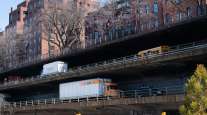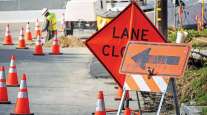Senior Reporter
Coalition Rallies to Promote States’ Infrastructure Priorities

This story appears in the Feb. 20 print edition of Transport Topics.
Groups representing business executives, manufacturers and private investors joined forces this month to draw attention to the hundreds of infrastructure projects governors would like the Trump administration to fund in a long-term plan.
The Coalition to Modernize American Infrastructure, led by the Bipartisan Policy Center think tank in Washington, includes the National Association of Manufacturers, the U.S. Chamber of Commerce and the Business Roundtable.
The National Governors Association, also in the coalition, recently sent to the White House a list of 428 projects ranging from ports and freight corridors to pipelines and bridges. Neither the Trump administration nor the association revealed the list to the public.
Sue Gander, transportation director at the National Governors Association, explained the list’s objective is to help Trump officials better understand the large-scale projects on the governors’ radars.
“It’s a very open-ended type of query. But it’s significant that it was across a variety of different infrastructure assets,” Gander said at the coalition’s kickoff Feb. 13. “I also point to the fact that it’s a pretty high number. We’re asking states for five or six examples. We got a lot more than that.”
She said the number of projects also signals an opportunity: “to move forward when we do get the funding and financing, and permitting worked out.”
Sarah Kline, a transportation fellow with the Bipartisan Policy Center, said while a comprehensive list is valuable, the governors eventually will need to explain how it was assembled.
“It’s important for states to be able to answer the question: ‘If you had x-amount of money, what do you do with it? What are your needs?’ And that type of information has not always been easily accessible,” Kline said.
“Did they do a cost-benefit analysis of which project is the most critical for their state’s economy or safety or quality of life. What was the criteria that they used to decide which project goes on the list,” she added.
Several state transportation officials already pointed to local projects they would like to see renovated with support from the federal government. In Washington state, for instance, officials are pressing for a bridge replacement project and road upgrades along Interstate 5. In California, officials indicated they would like to advance express lanes meant to relieve freight congestion in the San Francisco Bay area.
At their State of the States addresses in January, the governors of Virginia and Nevada pressed President Trump to advance a massive infrastructure package aimed at fixing bridges, alleviating congestion along freight corridors and replacing pipelines. The governors will hammer home that sentiment when they meet in Washington during Feb. 24-27 for their association’s annual meeting.
At a Senate hearing Feb. 15, Christopher Lofgren, president and CEO of Schneider, urged lawmakers for more federal spending on infrastructure.
“Underinvestment in our nation’s surface transportation infrastructure produces inefficiencies in the way we move goods, wastes fuel and increases operating costs,” Lofgren said. “With U.S. freight volume anticipated to increase 45% by the year 2040, the system must be updated and prepared for this surge. Otherwise, our environment and economy will suffer.”
His trucking company joins in the freight industry’s clarion call for improvements to the nation’s infrastructure, considering most of the nation’s goods are moved by ground. Surface transportation networks deemed deficient or obsolete contribute to congestion, according to stakeholders reviewing the issue.
Sens. Deb Fischer (R-Neb.) and Cory Booker (D-N.J.), commercial transportation policymakers, pledged to work with Republican leaders in advancing a long-term infrastructure funding bill aimed at modernizing critical freight corridors.
Trump pledged to advance a measure during his first 100 days in office that would generate a $1 trillion investment in infrastructure over a decade by providing tax credits to investors.
The American Society of Civil Engineers, which gave the country’s infrastructure a near-failing grade in 2013, has noted $1 trillion would be insufficient to modernize the network. The engineers will unveil a new infrastructure report card March 9.
But it offered a glance at the quadrennial report Feb. 15 with the premier of its documentary “Dream Big,” a film that highlights engineering triumphs.




